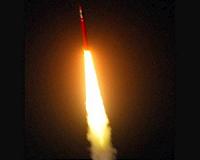 |
Huntsville AL (SPX) May 28, 2010 Fire and sparks flew as a 24-inch-diameter solid rocket motor was successfully tested May 27 at NASA's Marshall Space Flight Center in Huntsville, Ala. The 21-second firing tested a NASA sub-scale motor designed as a versatile, quick-turnaround and low-cost way to determine the performance of new materials and designs. This 24-inch-diameter, 109-inch-long motor utilized propellant and a case reconfigured from space shuttle test equipment. The test motor's nozzle was replaced with a new design scaled from the Ares I first-stage development motor, but could also be modified to accommodate different mission profiles or different sized vehicles, including heavy-lift vehicles. The test data will be evaluated to better understand the performance of the new nozzle configuration, processes and materials. "A rocket's nozzle needs to be protected from the incredibly harsh environment to which it is exposed during launch. A full-scale solid rocket motor's nozzle must survive a two minute launch at over 5000-degrees Fahrenheit," said Scott Ringel, an engineer at the Marshall Center and the design lead for this test. "We need to ensure our materials and designs can hold up, and small-scale tests like this one give us added confidence." NASA is a unique customer for many materials and requires highly reliable systems, thoroughly tested and evaluated for human spaceflight programs. One change in the availability of a part, supplier or material can potentially impact vehicle design, flight operations and mission assurance. Finding adequate replacements involves extensive testing and qualification efforts. Testing a sub-scale version of a rocket motor is a cost-effective way to assess new materials, technologies or processes, and rapidly evaluate performance. "We have extensive experience with thousands of materials used in the shuttle program, but many have become obsolete because of environmental concerns or industrial trends," added Ringel. "As new technologies drive the development of new materials, sub-scale testing ensures we can effectively replace obsolete materials with new and improved options." The test also includes two secondary objectives. The engineering team introduced an intentional defect into the propellant. A small cut was placed in the propellant inner diameter to verify the analytic methodology used to determine critical flaw sizes. The team hopes to gain a better understanding for the margin for error. In addition, NASA's Engineering and Safety Center will use data gleaned from this test to better understand the acoustics and vibration environment resulting from the rocket motor's plume. Engineers from the Marshall Center's Engineering Directorate designed the test article with support from ATK Aerospace Systems of Huntsville, Ala.
Share This Article With Planet Earth
Related Links Marshall Space Flight Center Rocket Science News at Space-Travel.Com
 Indian Rockets To Soon Use Atmospheric Oxygen As Fuel
Indian Rockets To Soon Use Atmospheric Oxygen As FuelBangalore, India (SPX) May 31, 2010 In an attempt to make its rockets lighter and carry heavier satellites, the Indian space agency is planning to flight test by the end of this year its own air-breathing engine that will use atmospheric oxygen as fuel. Air-breathing engines use atmospheric oxygen and burn it with the stored on-board fuel to generate the onward thrust. Conventional rockets carry both oxygen and chemica ... read more |
|
| The content herein, unless otherwise known to be public domain, are Copyright 1995-2010 - SpaceDaily. AFP and UPI Wire Stories are copyright Agence France-Presse and United Press International. ESA Portal Reports are copyright European Space Agency. All NASA sourced material is public domain. Additional copyrights may apply in whole or part to other bona fide parties. Advertising does not imply endorsement,agreement or approval of any opinions, statements or information provided by SpaceDaily on any Web page published or hosted by SpaceDaily. Privacy Statement |